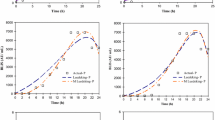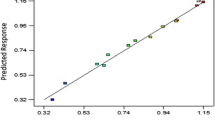Abstract
To investigate the effect of pH and temperature on the cell growth and bacteriocin production of Pediococcus acidilactici PA003, a lactic acid bacterium isolated from traditionally fermented cabbage, the kinetic behaviour of P. acidilactici PA003 was simulated in vitro during laboratory fermentations by making use of MRS broth. Firstly, primary models were developed for cell growth, glucose consumption, lactic acid and bacteriocin production for a given set of environmental conditions. Based on primary models, further study was undertaken to fit secondary models to describe the influence of temperature and pH on microbial behaviour. The models were validated successfully for all components. The results from the cell yield coefficient for lactic acid production reflected the homofermentative nature of P. acidilactici PA003. Both cell growth and bacteriocin production were very much influenced by changes in temperature and pH. The optimal condition for specific growth rate and biomass concentration was almost the same at pH 6.5 and 35 °C. At 35 °C and pH 6.1, the maximal bacteriocin activity was also achieved. The kinetic models provide useful tools for elucidating the mechanisms of temperature and pH on the kinetic behaviour of P. acidilactici PA003. The information obtained in this paper may be very useful for the selection of suitable starter cultures for a particular fermentation process and is a first step in the optimization of food fermentation processes and technology as well.




Similar content being viewed by others
References
Aktypis, A., Tychowski, M., Kalantzopoulos, G., & Aggelis, G. (2007). Antonie Van Leeuwenhoek, 92, 207–220.
Atala, D. I. P., Costa, A. C., Maciel, R., & Maugeri, F. (2001). Applied Biochemistry and Biotechnology, 91–93, 353–366.
Cheigh, C. I., Choi, H. J., Park, H., Kim, S. B., Kook, M. C., Kim, T. S., Hwang, J. K., & Pyun, Y. R. (2002). Journal of Biotechnology, 95, 225–235.
Daba, H., Pandian, S., Gosselin, J. F., Simard, R. E., Huang, J., & Lacroix, C. (1991). Applied and Environmental Microbiology, 57, 3450–3455.
Daeschel, M. A., McKeney, M. C., & McDonald, L. C. (1990). Food Microbiology, 7, 91–98.
De Vuyst, L., & Vandamme, E. J. (1994). Lactic acid bacteria and bacteriocins: Their practical importance. In L. De Vuyst & E. J. Vandamme (Eds.), Bacteriocins of lactic acid bacteria, microbiology, genetics and applications (pp. 1–11). London: Blackie Academic and Professional.
De Vuyst, L., Callewaert, R., & Pot, B. (1996). Systematic and Applied Microbiology, 19, 9–20.
De Vuyst, L., Callewaert, R., & Crabbé, K. (1996). Microbiology, 142, 817–827.
Dengremont, E., & Membré, J. M. (1995). Applied and Environmental Microbiology, 61, 4389–4395.
Drosinos, E. H., Mataragas, M., Nasis, P., Galiotou, M., & Metaxopoulos, J. (2005). Journal of Applied Microbiology, 99, 1314–1323.
Gálvez, A., Abriouel, H., López, R. L., & Omar, N. B. (2007). International Journal of Food Microbiology, 120, 51–70.
Holzapfel, W. H. (2002). International Journal of Food Microbiology, 75, 197–212.
Lejeune, R., Callewaert, R., Crabbe, K., & De Vuyst, L. (1998). Journal of Applied Microbiology, 84, 159–168.
Leroy, F., & De Vuyst, L. (1999). Applied and Environmental Microbiology, 65, 974–981.
Leroy, F., & De Vuyst, L. (1999). Applied and Environmental Microbiology, 65, 5350–5356.
Mataragas, M., Metaxopoulos, J., Galiotou, M., & Drosinos, E. H. (2003). Meat Science, 64, 265–271.
Matsusaki, H., Endo, N., Sonomoto, K., & Ishizaki, A. (1996). Applied Microbiology and Biotechnology, 45, 36–40.
Moretro, T., Aasen, I. M., Storro, I., & Axelsson, L. (2000). Journal of Applied Microbiology, 88, 536–545.
Neysens, P., & De Vuyst, L. (2005). Trends in Food Science and Technology, 16, 95–103.
Parente, E., & Ricciardi, A. (1994). Letters in Applied Microbiology, 19, 12–15.
Parente, E., Ricciardi, A., & Addario, G. (1994). Applied Microbiology and Biotechnology, 41, 388–394.
Rajaram, G., Manivasagan, P., Thilagavathi, B., & Saravanakumar, A. (2010). Advanced Journal of Food Science and Technology, 2, 138–144.
Rosso, L., Lobry, J. R., Bajard, S., & Flandrois, J. P. (1995). Applied and Environmental Microbiology, 61, 610–616.
Schillinger, U., Geisen, R., & Holzapfel, W. H. (1996). Trends in Food Science and Technology, 71, 58–64.
Smith, J. L., & Palumbo, S. A. (1983). Journal of Food Protection, 46, 997–1006.
Stiles, M. E. (1996). Antonie Van Leeuwenhoek, 70, 331–345.
Todorov, S., Gotcheva, B., Dousset, X., Onno, B., & Ivanova, I. (2000). Biotechnology and Biotechnological Equipment, 14, 50–55.
Van den Berghe, E., Skourtas, G., Tsakalidou, E., & De Vuyst, L. (2006). International Journal of Food Microbiology, 107, 138–147.
Wijtzes, T., De-Wit, J. C., Huis ińt Veld, J. H. J., Vańt Riet, K., & Zwietering, M. H. (1995). Applied and Environmental Microbiology, 61, 2533–2539.
Ye, H., Zhi Jiang, Z., Ping Ping, W., & Li Xia, Z. (2008). Journal of Jilin Agricultural University, 30, 360–363.
Zwietering, M. H., De-Wit, J. C., & Notermans, S. (1996). International Journal of Food Microbiology, 30, 55–70.
Acknowledgments
This work was supported by the National Natural Science Foundation of China (no. 31101275), the Tianjin Natural Science Foundation (no. 08JCZDJC22500) and a research grant (no. 20100207) from Tianjin University of Science and Technology, China.
Author information
Authors and Affiliations
Corresponding author
Rights and permissions
About this article
Cite this article
Zhang, J., Zhang, Y., Liu, Sn. et al. Modelling Growth and Bacteriocin Production by Pediococcus acidilactici PA003 as a Function of Temperature and pH Value. Appl Biochem Biotechnol 166, 1388–1400 (2012). https://doi.org/10.1007/s12010-011-9532-4
Received:
Accepted:
Published:
Issue Date:
DOI: https://doi.org/10.1007/s12010-011-9532-4




